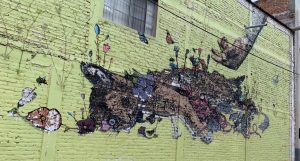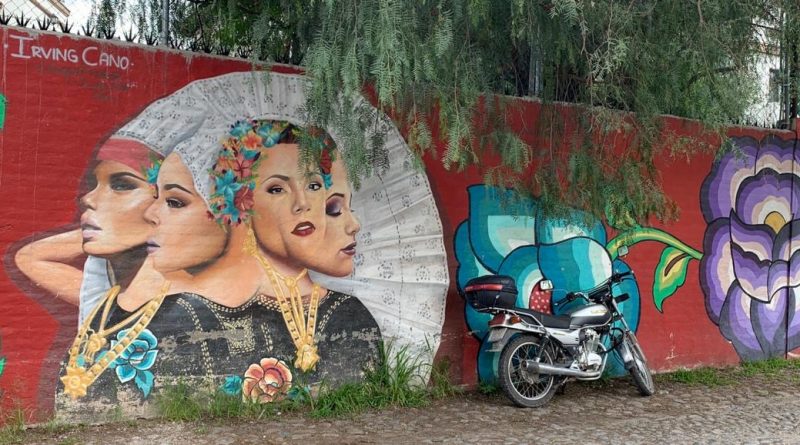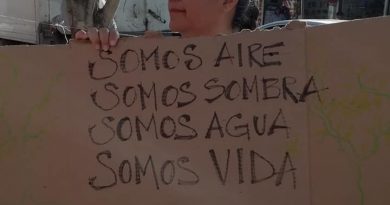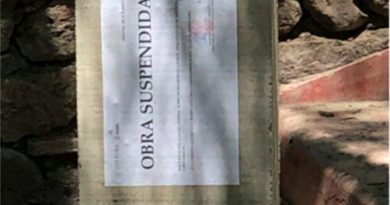Art Highlights Divisions in the Colonia Guadalupe
Mexico has a long and rich tradition of public art that inspires, provokes, and enriches our communities. The best of this art helps us to look at ourselves and our world in a new way. It is definitely doing that in the Colonia Guadalupe, where a conflict has been brewing for some time about the murals. A few weeks ago, several threads appeared amongst English speakers on Facebook, suggesting that the government or secret, nefarious forces were trying to destroy the mural project. After investigating these claims thoroughly, we found absolutely no one who wanted the murals removed. But, like art should, they are forcing residents to look at the changes within and challenges facing their neighbourhood.
Like most of San Miguel, the Colonia Guadalupe was a very traditional neighbourhood centered around the church and the many orchards until recently. A few years ago, the neighbourhood began to grow due to its safety, proximity to centro and popularity with foreigners. Older buildings were knocked down to make way for spec houses. The orchards were gradually consumed by new stores and restaurants. In 2012, an American named Colleen Sorenson, started the Muros en Blanco project to coincide with the Calaca Festival. She brought graffiti artists from all over Mexico to express themselves on the walls of the colonia. The first festival was well-supported and well-attended. The atmosphere was exciting, creative and fun. At that time, it appears that everyone was in favor of the project. In recent months and years though the general attitude has changed. It seems that much of this change is due to a lack of communication between newcomers and those that have made their homes in the Guadalupe for generations. Whereas many newcomers love the idea of a funky art district, some of the older residents are uncomfortable with the murals and what they represent. Moreover, many are offended by Muros en Blanco’s publicity which states that the Colonia was “high risk” and characterized by “theft, vandalism, drug addiction and abandonment” until they moved in, creating further divisions within the community. All this has been brewing under the surface for some time.
Earlier this year, due to the security crisis, many neighbourhoods in San Miguel organized Whatsapp groups and neighborhood committees to keep each other informed and help each other out. Guadalupe was probably the most effective colonia in the city at organizing block by block. As neighbours connected, the murals came up as a topic of concern and conversation began amongst residents about the future of the project. Everything really came to a head a few months ago when the government offered to re-plaster and paint 200 houses. Many who applied had murals that they either didn’t like or that had deteriorated. This caused the panic on social media amongst those with the mistaken impression that the mural project was under attack. But again, no one wants to end the project. Muros en Blanco is justifiably protective of what they have begun but he neighborhood committee believes all residents should have a say in the project. There are really only two concerns they would like to address: maintenance and subject matter.
As far as anyone can tell, there was never a plan for long term maintenance. Murals are by nature temporary; peeling and fading are inevitable with exposure to the elements. Should they be touched-up and restored regularly? Allowed to fade away? Painted over after a certain amount of time? The issue is complicated by the question of ownership. It seems logical that a mural on private property belongs to the owner of the property. But paint is expensive. Are property owners responsible for painting over a work that has deteriorated or that they don’t like? Do the artists have a say in what happens to their work? Does Muros en Blanco? These are questions that the neighbourhood committee is looking at.

The issue of subject matter and aesthetics is more complicated. A lot of Guadalupe residents simply do not like many of the murals. Others find them confusing. Some say that there are too many. We heard the term “visual pollution” used many times Art is highly subjective and good art should be provocative. But while we love the idea of artists having free reign to express themselves, and we find the idea of placing limits on art worrying, perhaps there do need to be some guidelines when it comes to public art. The neighborhood committee is looking at the idea of a unified theme, as broad or narrow as residents choose, much like they use in cities like Tepoztlán. One theme could be the history of San Miguel, or, more specifically, the history of the Guadalupe and the Aurora. Another idea was to follow the theme of the street names. They are also looking at a possible colour scheme. They have submitted many of their ideas to Muros en Blanco and hope to come to a shared vision of the future together soon.
San Miguel has grown so quickly, and change is hard for all of us. The population a hundred years ago was less than 7000 people. Those who have arrived in the last few years and decades come from all over Mexico and the world. They bring with them differing visions of culture and community. We at the Observatorio believe that through open, honest, discussion and good-willed negotiation, residents, independent artists, the neighbourhood committee, and Muros en Blanco, can come up with a plan to maintain the tradition of public art that will continue to inspire us all.




